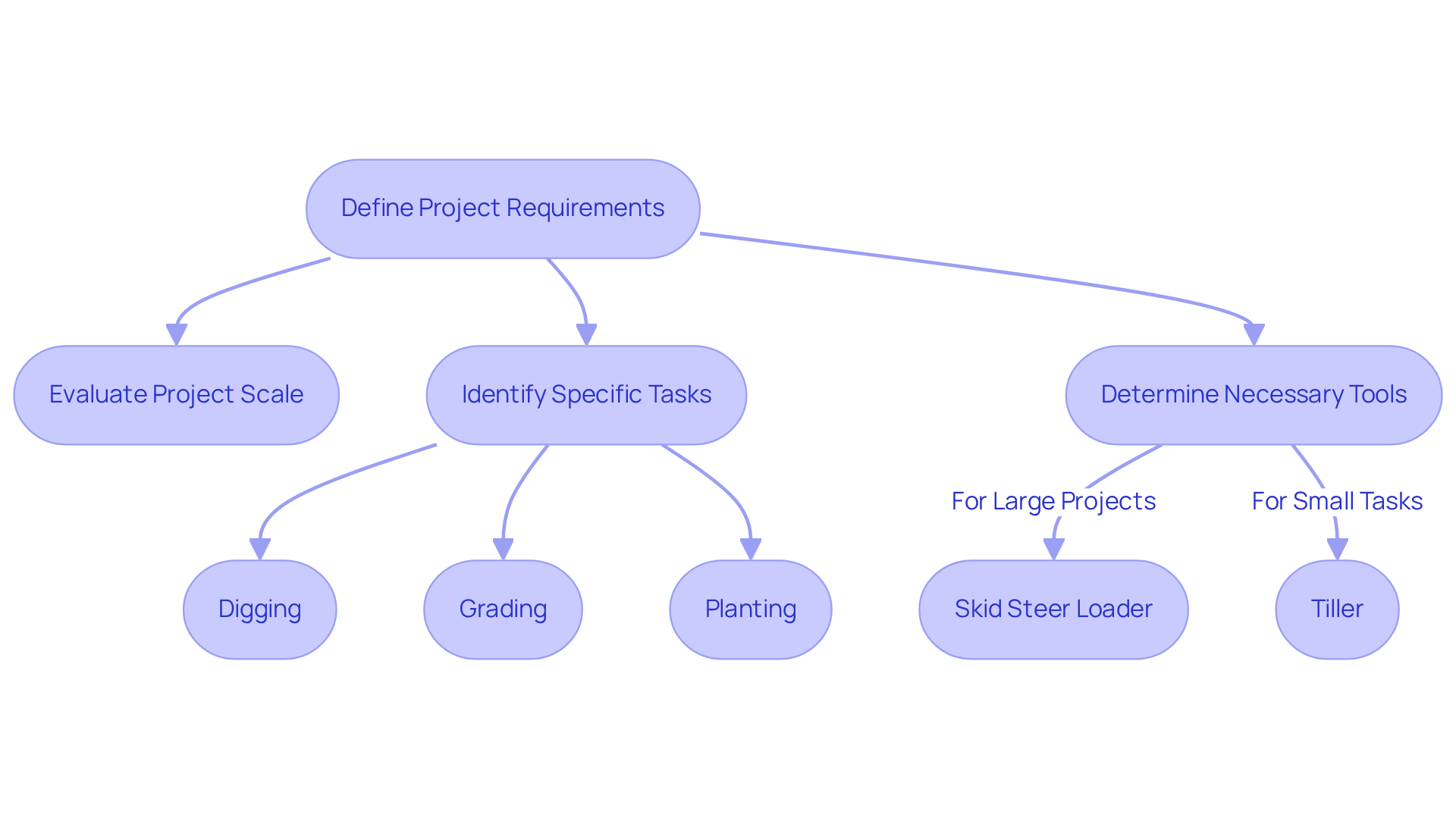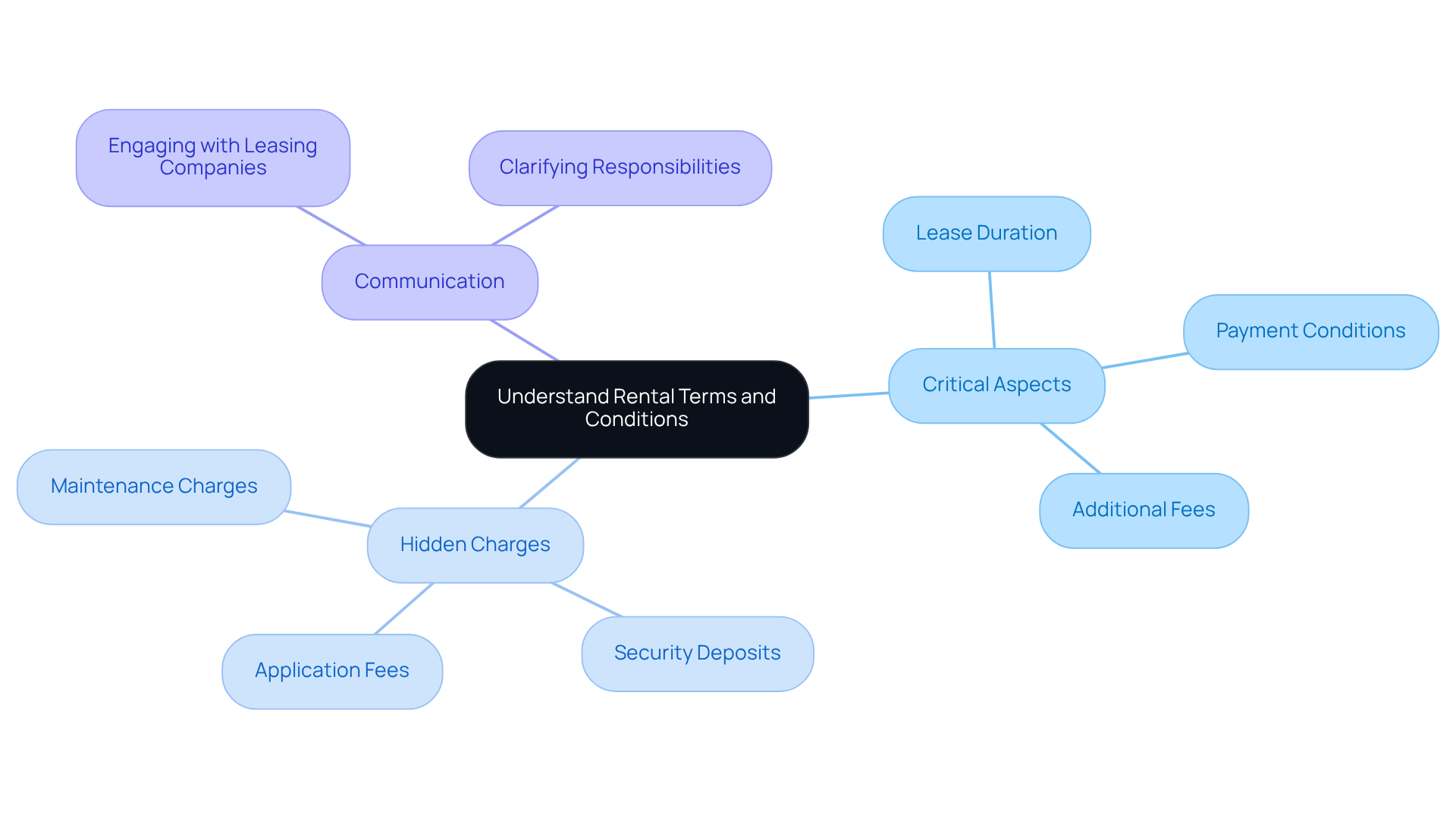Overview
The article delineates four essential steps for successful landscaping machine rental:
- Defining project requirements
- Selecting appropriate tools
- Researching rental companies
- Understanding rental terms
Each step is bolstered by practical advice; for instance, assessing project scale is crucial for choosing the right equipment, while thoroughly reviewing lease agreements is imperative to avoid hidden fees. This approach ensures a smooth and efficient rental process, guiding you towards making informed decisions.
Key Highlights:
- Define project requirements by outlining tasks such as digging, grading, and planting, and assess the scale of the project.
- Select appropriate tools based on specific tasks and work area limitations; for example, use a skid steer loader for large spaces and a tiller for smaller tasks.
- Understand typical landscaping project dimensions in the U.S. to inform tool selection; residential projects range from 1,000 to 5,000 square feet, while commercial projects exceed 10,000 square feet.
- Research and evaluate rental companies by checking online reviews, the range of tools offered, and their maintenance practises.
- Inspect rental equipment thoroughly for damage, operational safety features, and maintenance history before finalising the rental.
- Review lease agreements carefully to understand terms, payment conditions, and potential hidden fees such as application charges and security deposits.
- Engage with rental companies to clarify any uncertainties regarding responsibilities and costs to avoid misunderstandings.
Introduction
Navigating the world of landscaping machine rentals can feel overwhelming due to the myriad of options and requirements to consider. It is crucial to understand the specific needs of a project, as the right tools can significantly impact the outcome. Many renters encounter challenges in:
- Selecting appropriate equipment
- Evaluating rental companies
- Deciphering complex lease agreements
To ensure a seamless rental experience while avoiding common pitfalls, one must focus on maximizing project success.
Define Your Project Requirements
To guarantee a successful landscaping endeavor, it is essential to outline all tasks that the rented tools will need to complete. Consider the scale of your project—whether it involves a small garden or a large commercial site. Evaluate specific tasks such as:
- Digging
- Grading
- Planting
Determine the necessary tools for each task. For example, a skid steer loader is ideal for leveling large spaces, while a smaller task may only require a tiller. Furthermore, assessing the work area and recognizing any spatial limitations is vital, as these elements can significantly impact your selection of tools.
Statistics indicate that the typical dimensions of landscaping endeavors in the U.S. fluctuate considerably, with numerous residential projects spanning from 1,000 to 5,000 square feet, whereas commercial ventures can exceed 10,000 square feet. Understanding these dimensions aids in selecting the appropriate tools. As emphasized by landscaping experts, accurately evaluating task requirements is crucial; one specialist states, "Selecting the appropriate tools can determine the effectiveness of your endeavor."
In the context of tool leasing, it is important to recognize that the landscaping machine rental sector is projected to expand significantly, driven by increasing demand for professional services and technological innovations. This growth underscores the importance of making informed decisions regarding tool leasing to enhance results.

Research and Evaluate Rental Companies
When exploring landscaping machine rental options in Irving, TX, it is essential to compile a comprehensive list of alternatives, including reputable firms like EZ Tool Leasing. Begin by examining online reviews and ratings to assess customer satisfaction. Consider the range of landscaping machine rental tools offered, such as:
- Boom lifts
- Excavators
- Forklifts
Ensure they align with your project requirements. Reach out to each company to inquire about their leasing policies, availability, and pricing. Furthermore, ask about their maintenance practices to confirm the tools are well-kept. A reliable company, such as , should transparently communicate their leasing conditions and be responsive to any questions you may have.
In addition to evaluating service offerings, it is crucial to understand the benefits of each equipment type. Boom lifts provide excellent reach for high-altitude tasks, while excavators are indispensable for heavy-duty digging. Forklifts enhance efficiency in material handling, making them vital for various projects. By selecting the right tools, you can ensure that your operations run smoothly and effectively.
Finally, do not hesitate to take action. Contact these companies today to discuss your specific needs and discover how they can support your project. The right equipment can make all the difference, so ensure you choose a trustworthy partner in your tool leasing journey.
Inspect Equipment Before Renting
Before finalizing your rental, it is crucial to conduct a thorough examination of the tools. Begin by inspecting for visible signs of damage, such as dents, rust, or leaks, which may indicate underlying issues. Ensure that all safety features are operational; modern construction tools frequently incorporate advanced safety features, including motion sensors and facial recognition technology. If you are unfamiliar with the tools, request a demonstration to gain a deeper understanding of their functionality.
Furthermore, verify that the equipment has been properly maintained and serviced; asking for maintenance records can provide valuable insight into its operational history. This step is especially important, as approximately 40% of fleet managers have reported increasing maintenance budgets to extend the lifespan of their assets.
By taking these precautions, you can significantly mitigate the risk of unexpected breakdowns and delays during your project, ensuring a smoother workflow and adherence to timelines. As the demand for eco-friendly equipment continues to rise, confirming that the machinery meets these standards is also a vital component of your inspection process.

Understand Rental Terms and Conditions
Thoroughly reviewing the lease agreement is essential before signing. Focus on critical aspects such as lease duration, payment conditions, and any additional fees that may arise, including late return charges or cleaning costs. Statistics reveal that hidden charges are common in lease agreements, with many tenants unaware of potential expenses until after signing. Typical concealed costs may include:
- Application fees
- Security deposits
- Maintenance charges
It is vital to clarify your responsibilities regarding equipment maintenance and any damages that may occur during the borrowing period. Engaging in a dialogue with the leasing company about any uncertainties can prevent misunderstandings and unexpected expenses. Legal experts emphasize that understanding these terms is crucial for a seamless leasing experience, enabling you to navigate the agreement confidently and avoid pitfalls that could lead to extra costs. Furthermore, the knowledgeable team at EZ Equipment Rental is available to assist you in comprehending these terms, ensuring a positive rental experience.

Conclusion
Successful landscaping machine rental relies on a well-structured approach that involves careful planning, thorough research, and informed decision-making. By adhering to these essential steps, individuals can confidently select the right tools, partner with reputable rental companies, and grasp the intricacies of rental agreements—key factors that contribute to the success of their landscaping projects.
Defining project requirements is paramount, as it sets the foundation for evaluating rental companies based on their offerings and customer feedback. Furthermore, inspecting equipment for safety and maintenance ensures reliability, while comprehending the terms and conditions of rental agreements mitigates potential risks. Each of these elements plays a crucial role in enhancing the overall efficiency of the landscaping process.
In conclusion, dedicating time to meticulously plan and execute each step in the landscaping machine rental process not only leads to superior project outcomes but also creates a more enjoyable and stress-free experience. By prioritizing informed choices and proactive communication with rental companies, individuals can navigate the complexities of equipment leasing with confidence, ultimately achieving their landscaping goals more effectively.
Frequently Asked Questions
Why is it important to define project requirements for landscaping?
Defining project requirements is essential to outline all tasks that rented tools will need to complete, ensuring a successful landscaping endeavor.
What factors should be considered when planning a landscaping project?
Factors to consider include the scale of the project (small garden vs. large commercial site), specific tasks (digging, grading, planting), and spatial limitations of the work area.
How do project dimensions impact tool selection in landscaping?
Understanding the typical dimensions of landscaping projects, which can range from 1,000 to 5,000 square feet for residential projects and exceed 10,000 square feet for commercial ventures, aids in selecting the appropriate tools for the job.
What types of tools might be needed for different landscaping tasks?
For larger tasks, a skid steer loader is ideal for leveling spaces, while smaller tasks may only require a tiller.
What is the current trend in the landscaping machine rental sector?
The landscaping machine rental sector is projected to expand significantly due to increasing demand for professional services and technological innovations.
Why is it crucial to evaluate task requirements accurately?
Accurately evaluating task requirements is crucial because selecting the appropriate tools can determine the effectiveness of the landscaping endeavor.




